Hyderabad in southern India is a large city with two contrasting sides, old and new. It has modern, cosmopolitan suburbs contrasting the historical buildings of Old Town. We enjoyed exploring both.
The population of Hyderabad is 7 million, so we expected a hectic, crowded, polluted city. In fact, there are a number of peaceful, treed communities and relatively little pollution. The suburbs have many modern office buildings, shopping malls and Imax cinemas. In the centre of the city is a large lake with walking trails, boat rides and lake side dining.

Hussain Sagar (Lake), Hyderabad
The city was established in the 16th century and is known for its many historical sites. On the outskirts of Hyderabad is the impressive 16th century Golkonda Fort built by the reigning Sultan, Shah Qutub. The fort is surrounded by a tall stone wall which has interesting small features along the top. The wall encloses a large main lower level as well as a hilltop section. Once you enter through the main gate, there is an open-aired chamber with a vaulted ceiling. It’s called the ‘Clapping Portico’ because any sound made in this area resonates throughout the fort via a series of stone arches. The first doorbell!

Outer wall, Golkonda Fort , Hyderabad 
Outer wall, Golkonda Fort, Hyderabad 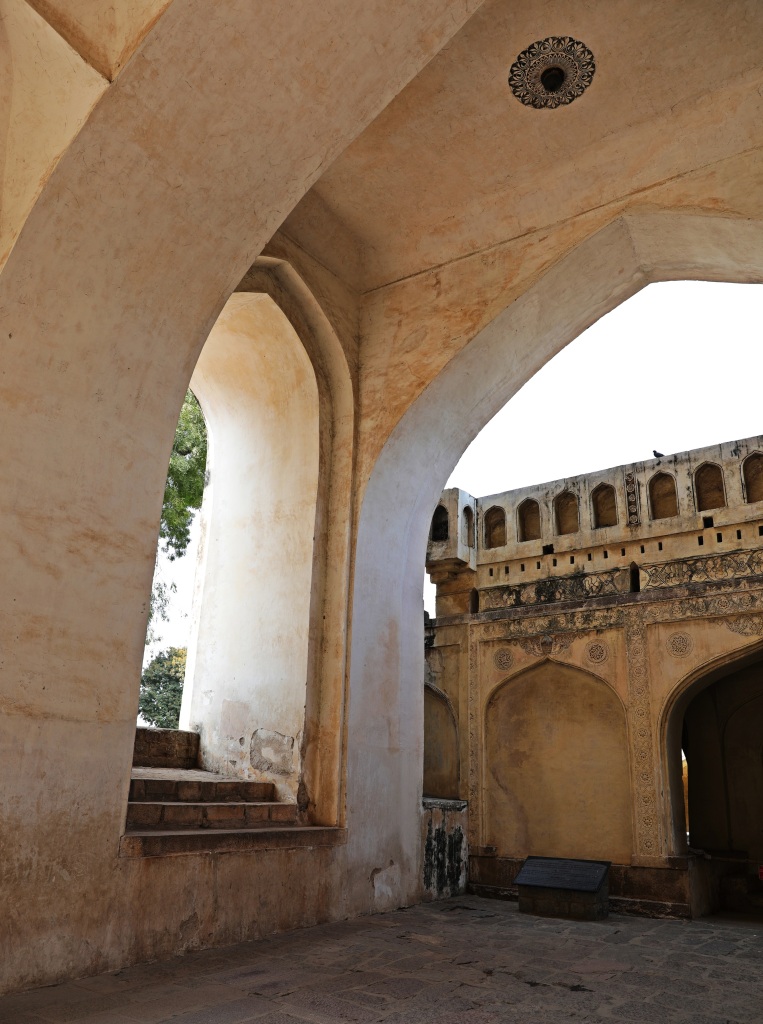
Clapping Portico, Golkonda Fort
Beyond this chamber, the grounds are filled with a large garden and many buildings in various stages of ruin. This lower level of the fort seems to go on and on, covering many city blocks. The buildings were built in brick and stone with arched doors and windows and high vaulted ceilings. Inside, there are large rooms with high ceilings and designs carved into the walls. There are also a few covered walkways between the buildings with similar arches but with low ceilings. Looking down the walkways, these arches line up to give an interesting view. .

Golkonda Fort, Hyderabad 
Inside one of the buildings, Golkonda Fort 
Decorated walls, Golkonda Fort 
Ruins at Golkonda Fort , Hyderabad 
Arched ceilings, Golkonda Fort, Hyderabad 
Inside one of the buildings, Golkonda Fort 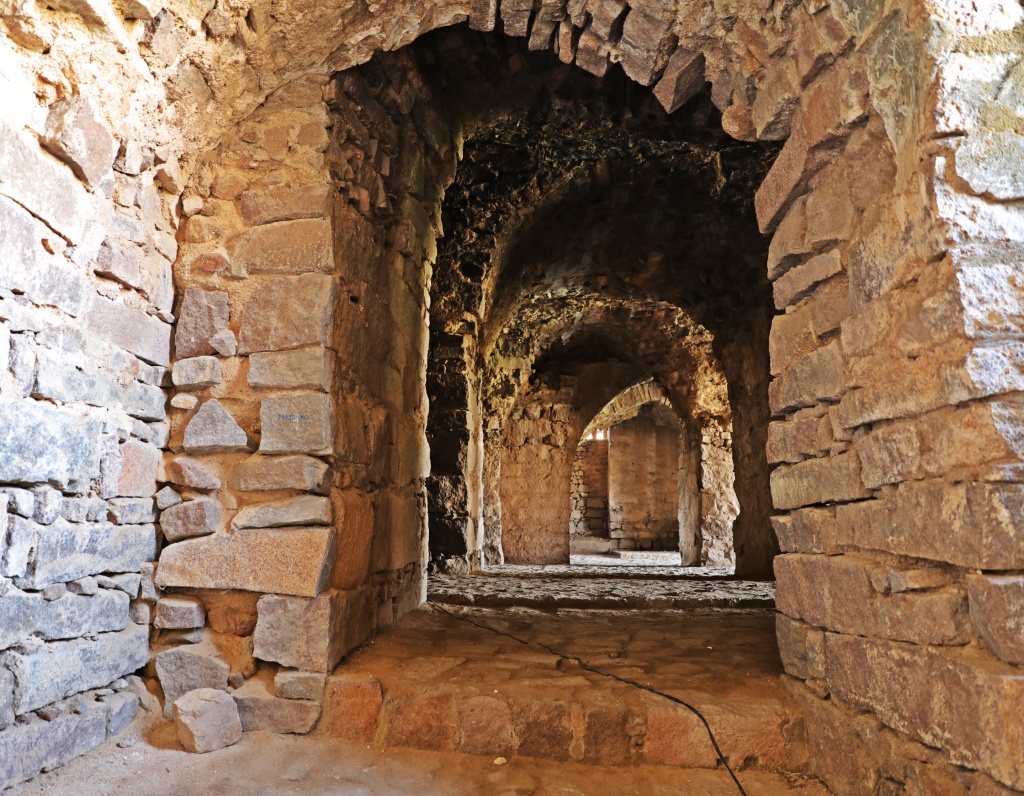
Golkonda Fort, Hyderabad 
Arched doorways, Golkonda Fort , Hyderabad 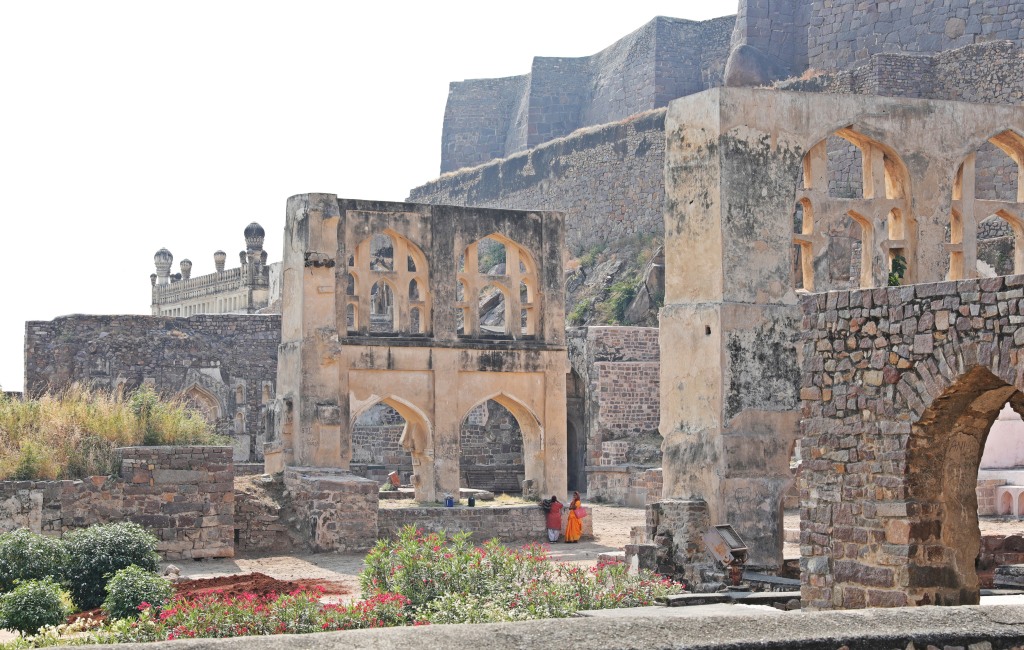
Golkonda Fort , Hyderabad 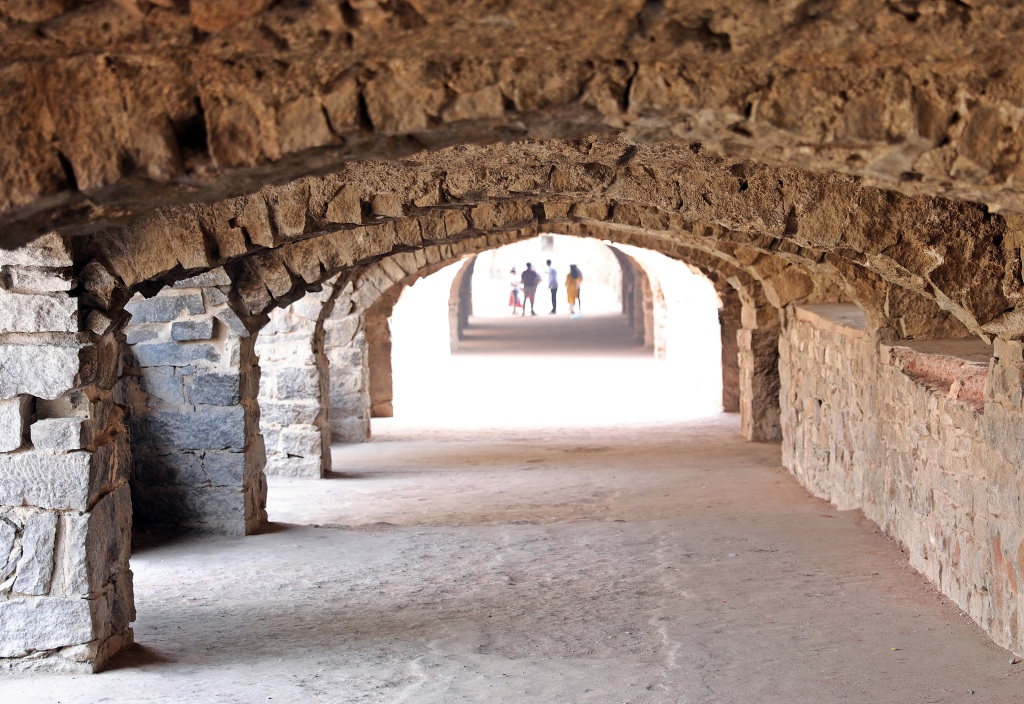
Covered walkway, Golkonda Fort
On a hill, 120m above the garden, is another walled section with a mosque and a temple. The hill has many large, granite boulders and this upper part of the fort incorporates these boulders in its design for a unique look. From this upper section, high on the hill we had views of the large city of Hyderabad.

Golkonda Fort, Hyderabad 
Golkonda Fort built on the granite boulders 
Golkonda Fort built on the granite boulders 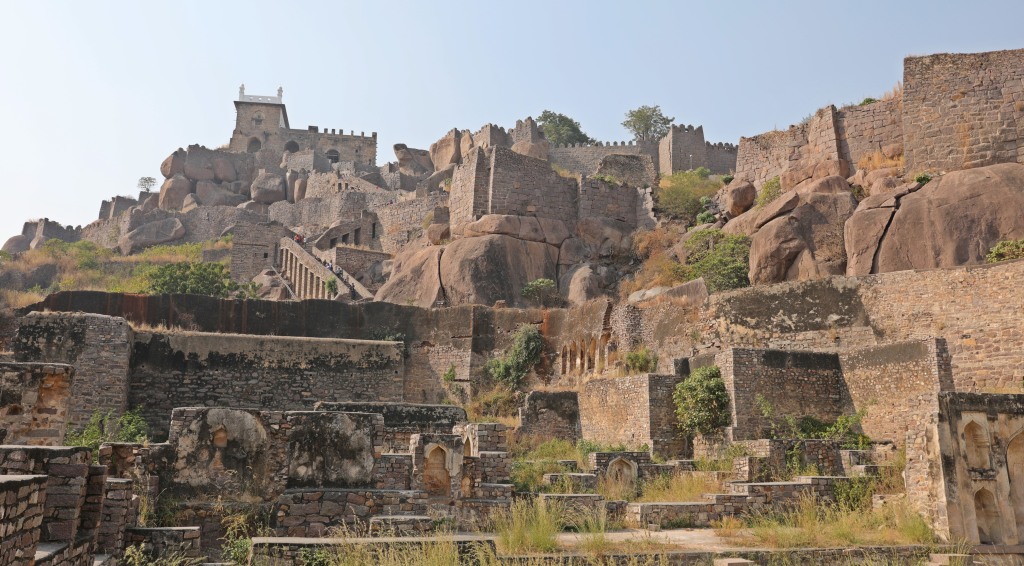
Golkonda Fort, Hyderabad 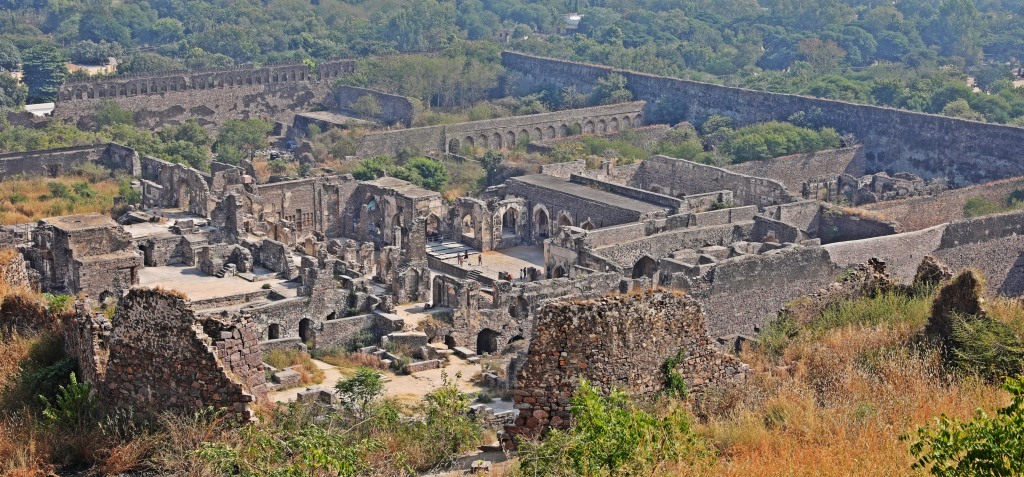
Golkonda Fort, Hyderabad 
View of Hyderabad from Golkonda Fort
Not far from the fort is a compound with 21 tombs for Shah Qutub, his family, consorts and favourite physician. They are all magnificent, square buildings with large onion-domed roofs. They have one or two stone sarcophagi inside and some have a few on the outside platforms. The Shah’s tomb stood out for its grandeur. It`s a large, colourfully tiled building set above the others on a large tiled stage. Inside Qutub Shah’s Tomb it had elaborate sculptures and a high vaulted ceiling.

Tomb in Qutub Shahi’s Complex 
Mosque, Qutub Shahi’s Complex 
Tomb in Qutub Shahi’s Complex 
Tombs in Qutub Shahi’s Complex 
Tombs in Qutub Shahi’s Complex 
Tombs in Qutub Shahi’s Complex 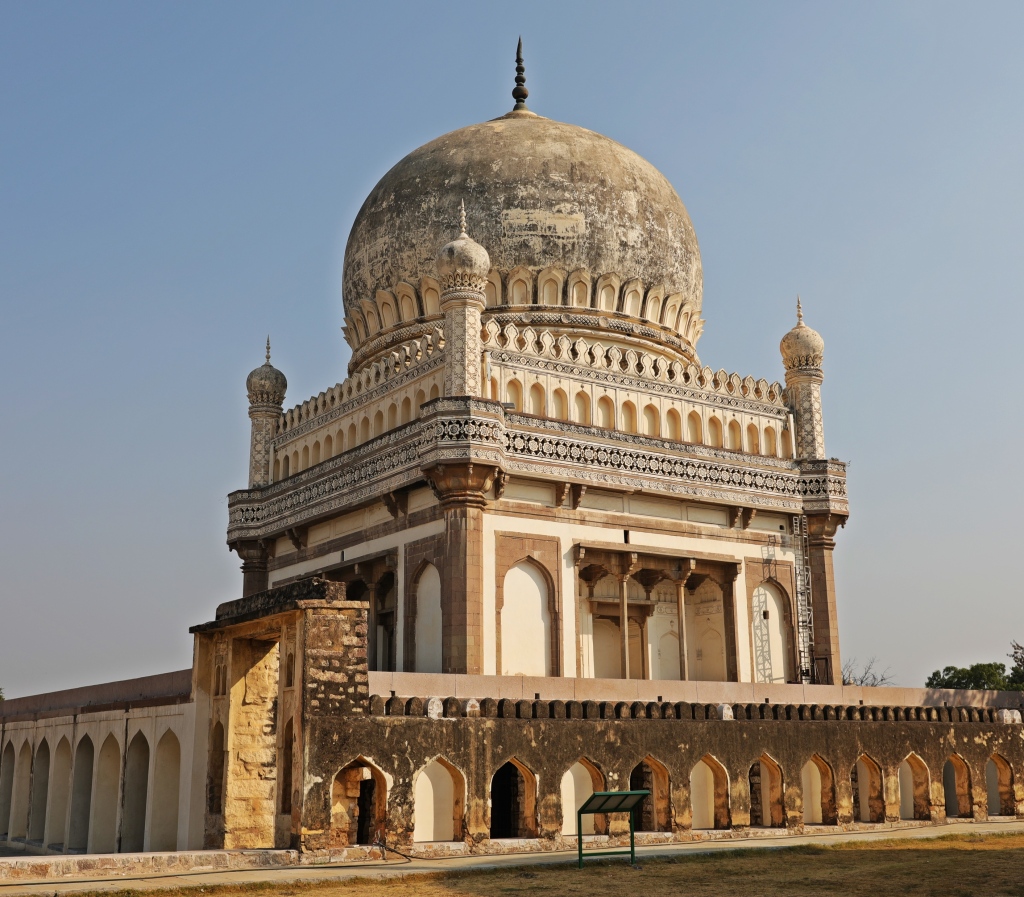
Qutub Shahi’s Tomb 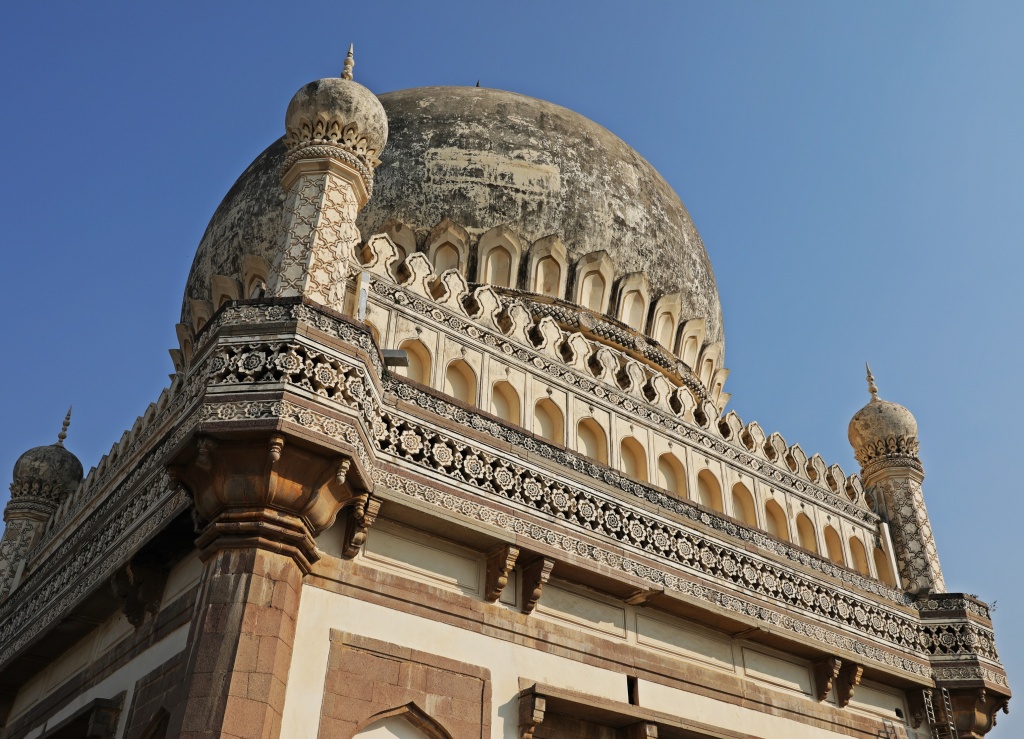
Qutub Shah’s Tomb 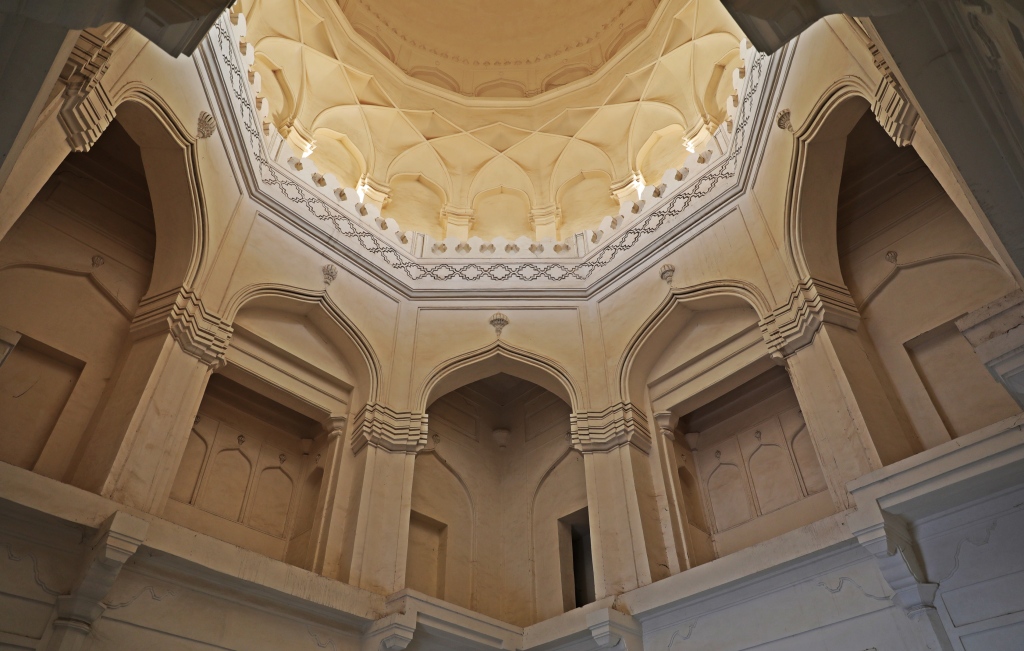
Inside Qutub Shah’s Tomb 
Mosque near Qutub Shah Tombs
To commemorate his founding of Hyderabad in the 16th century, Shah Qutub built Charminar. It’s a massive four-arched gate with high columns at the corners and minarets on top. As with most structures we’ve seen lately, this one was being renovated so was covered in scaffolding. Charminar is located in the middle of Old Town Hyderabad with one of the main, busy markets taking place on the streets around it. One of them is a bird market with many shops selling caged birds. It was so sad to see the wild, tropical birds cooped up in small cages. Hopefully they were being sold for pets and not dinner.
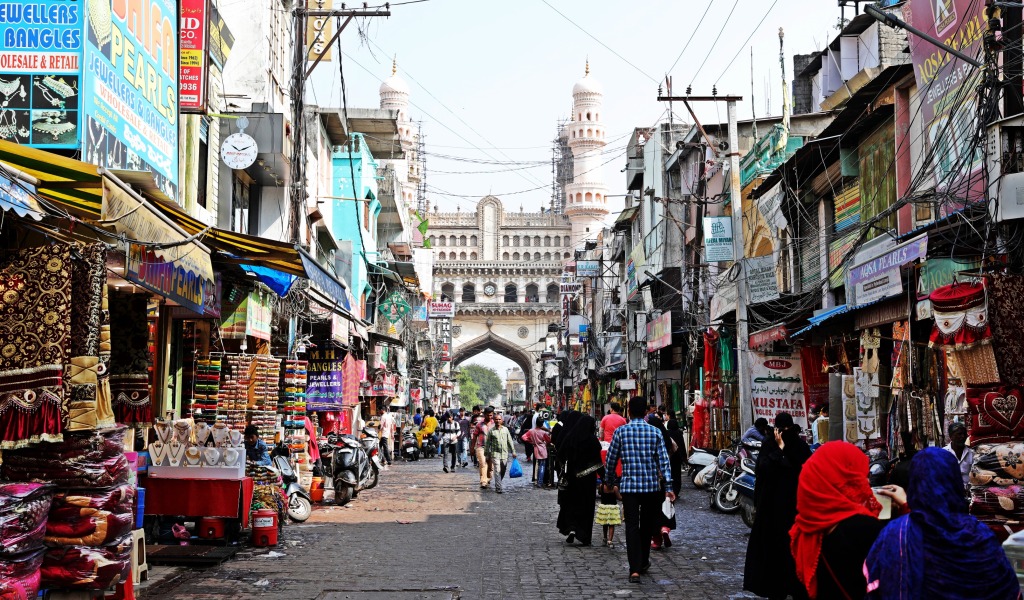
Charminar and market street, Hyderabad 
Charminar and market street, Hyderabad 
Market, Old Town, Hyderabad 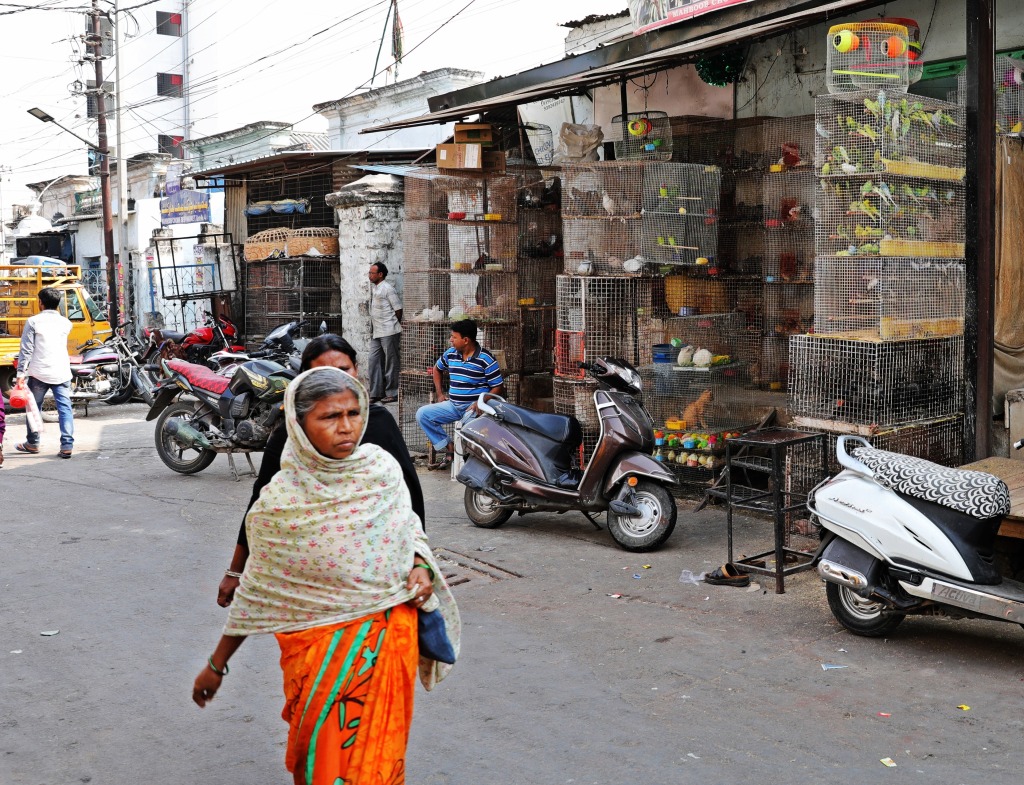
Bird market, Hyderabad
When the British ruled India, certain areas, including Hyderabad still maintained their Mughal king. When India regained independence, these kings were able to decide if they wanted to be in India, Pakistan or remain independent. The Hyderabad king, ruling a muslim population in a Hindu country chose to be an independent Muslim-led state. Since Hyderabad is located in the middle of the country with India surrounding it, this was not an ideal situation. After an Indian led invasion, that only lasted a few days, Hyderabad became a part of India. With this history, there is still a strong Muslim community in Hyderabad. The Muslim population is the majority at 60% of the total population.
There are also many Hindu Temples in the city. We visited an interesting one at night. Jagannath Temple has many colourful depictions of the various Hindu myths and legends on the courtyard’s wall.

Market, Old Town, Hyderabad 
Charminar and market street, Hyderabad 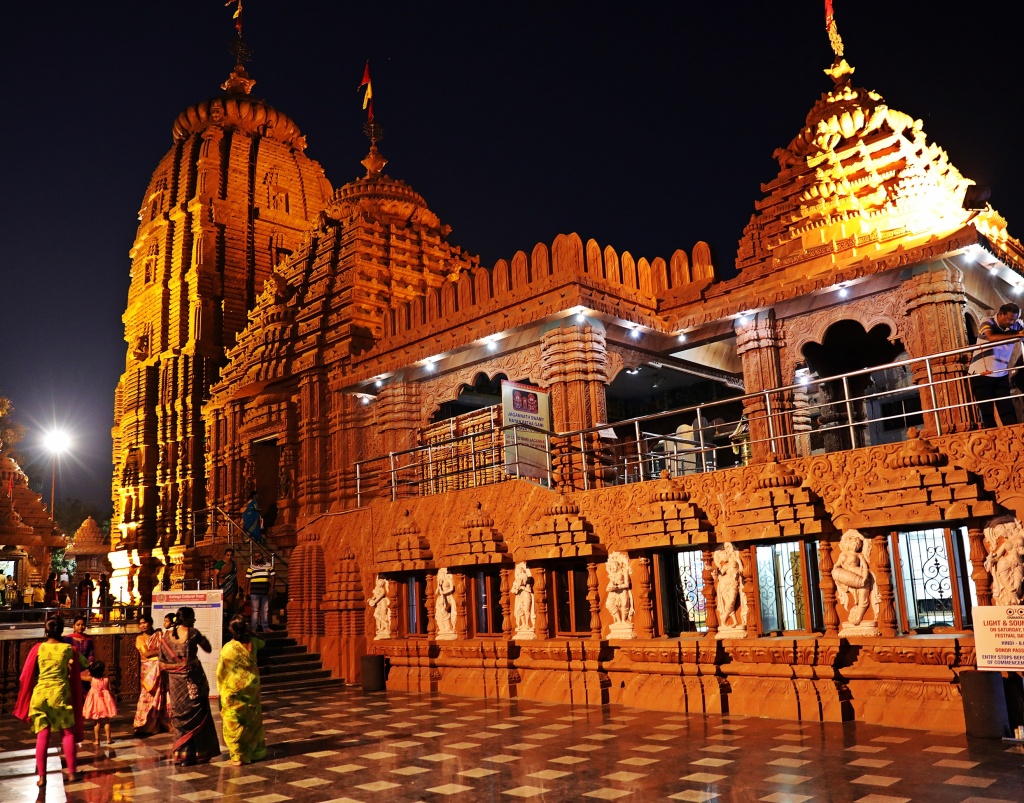
Jagannath Temple, Hyderabad 
Not far from the Charminar is the 18th century Chowmahalla Palace built by the Nizam Mughal Dynasty who took power from the Shah Dynasty. The entry to the grounds is through a very plain gate, but the first building you see is the grand Khilwat Mubarak. It’s set at the end of a long garden with a fountain and two long buildings on either side. The high columned palace is equally beautiful inside with intricate moldings and decorated ceilings in its many rooms. Dubar hall on the main floor has an unbelievable 19 massive, crystal chandeliers hanging from the ceiling making it feel very opulent.
The palace grounds have four garden courtyards and many other large halls that are now used as museums to display clothing, china and furniture that were used by the Nizam family. The family resided in the palace until the mid 20th century.

Khilwat Mubarak, Chowmahalla Palace, Hyderabad 
Khilwat Mubarak, Chowmahalla Palace, Hyderabad 
Chowmahalla Palace, Hyderabad 
Chandelliers, Durbar Hall, Chowmahalla Palace, Hyderabad 
Durbar Hall, Chowmahalla Palace 
Chowmahalla Palace, Hyderabad 
Chowmahlla Palace, Hyderabad 
Chowmahalla Palace, Hyderabad
At the southern end of Hyderabad are the Paigah Tombs. The wealthy Paigah family had close ties to the Nizam rulers in the 18th century and are still a prominent family in the city today. Instead of the grand buildings of Shah Qutub’s tombs, Paigah Tombs are interconnected, small, delicately decorated rooms inside two long, white, limestone buildings. There is a long corridor with arched doorways along the outside. The roofs have the most interesting designs with several small Turkish-style domes and lace-work along the eave. Inside, the rooms have square, marble canopies with a sarcophagus in the centre. There are very impressive, intricate designs on the walls and ceilings. Each room has a different motif for these exquistie designs. Between each room are windows made of beautifully detailed marble lattice work.
We met a lovely man who has been caretaker care of the site for 44 years. He took the position over from his father, who took over from his father. Three generations of proud caretakers.

Interesting roofs, Paigah Tombs, Hyderabad 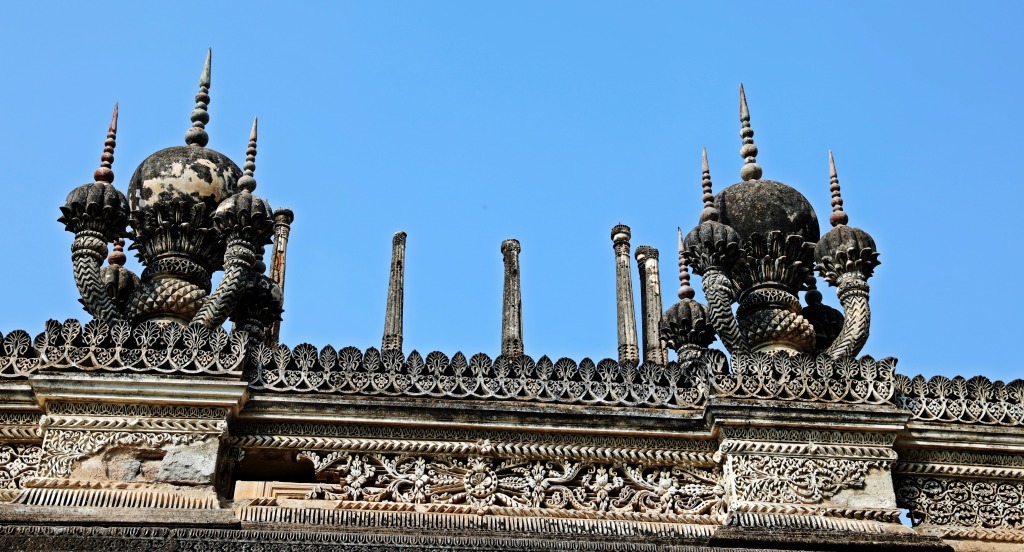
teresting roofs, Paigah Tombs 
Paigah Tombs, Hyderabad 
Paigah Tombs, Hyderabad 
Paigah Tombs, Hyderabad 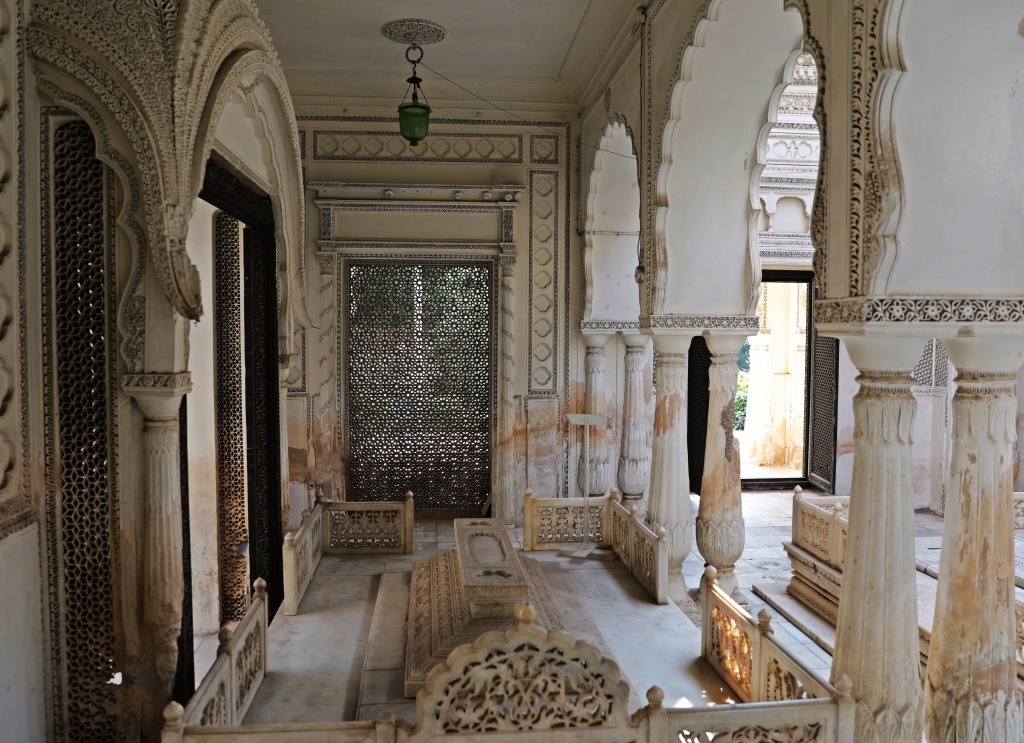
Paigah Tombs, Hyderabad 
Paigah Tombs, Hyderabad 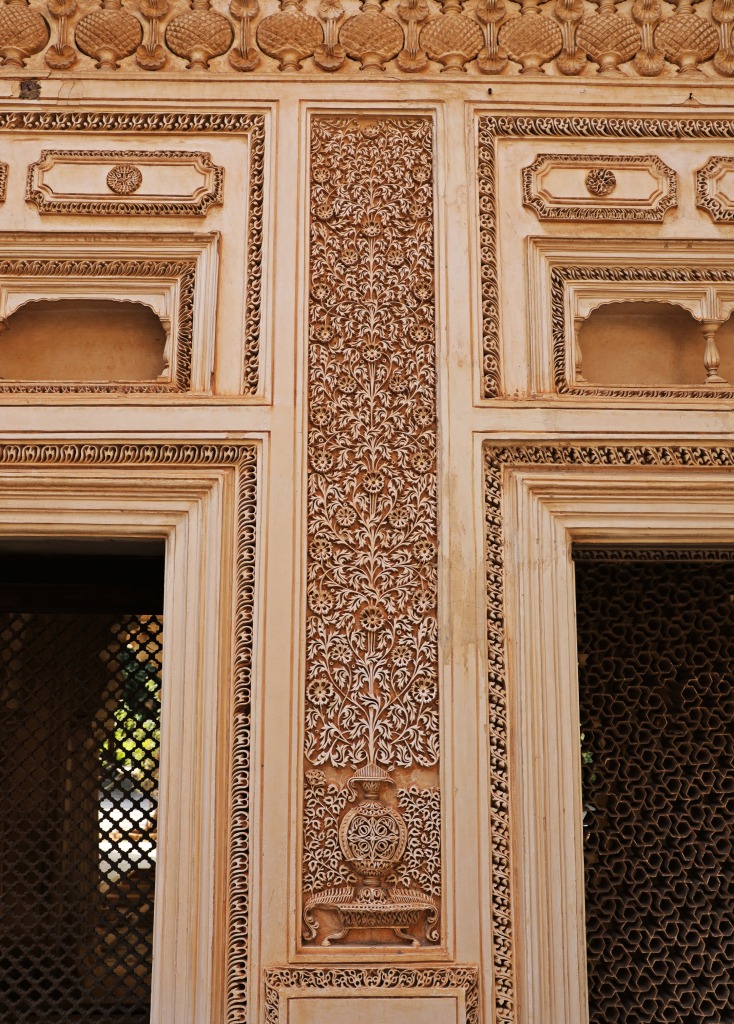
Intricate marble-work, Paigah Tombs, Hyderabad 
Caretaker, Paigah Tombs, Hyderabad
Hyderabad has a large number of IT companies and therefore a large population of educated, tech-savy people. There are many good restaurants and coffee shops to meet the needs for this growing middle class. We were lucky to stay with our friend Rahul whom we met earlier this year while trekking in Kashmir. He introduced us to the different cuisine of southern India. The dishes use spicy red and green chilies and are served with tangy, flavourful chutneys made from coconut, curry leaf, ginger and garlic. We also enjoyed paratha bread which is a flaky bread, similar to pasty. In Hyderabad their specialty dish is biryani. It’s a rice dish filled with the flavours of cloves, cinnamon and cardamom. We ate well in Hyderabad.
There is, however, some poverty in Hyderabad, but in one city slum, the city invested in a graffiti project. Artists painted the fences and buildings in graffiti in hopes of improving the look of the area as well as draw tourist dollars here. It seems like the locals didn’t like all of the strangers wandering their streets since the direction signs for the art work were covered and no one would give us correct directions to find all of the paintings.

Graffiti project, Hyderabad 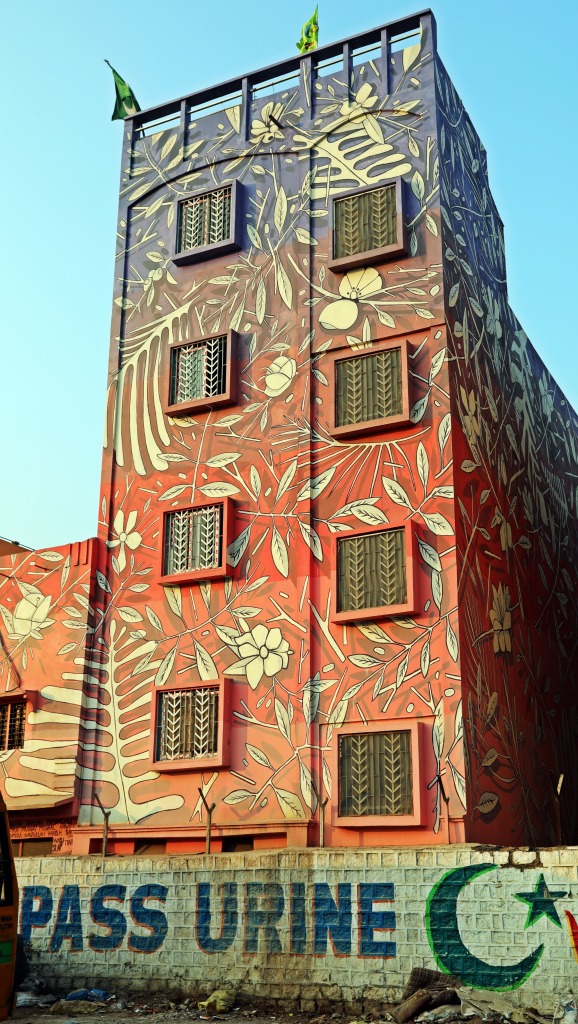
Graffiti project, Hyderabad 
Graffiti project, Hyderabad
Coming Next: Diving in the Andaman Islands.
For extra pics from this trip go to Gallery/Delhi & Eastern India. For extra pictures from other blogs go to Gallery at monkeystale.ca
To read about more of our adventures go to Destinations.
If you like what you read, please share it using the links below
Oh how happy I am to stumble upon your blog today! Your photos are beautiful, and you covered many corners of Hyderabad most people didn’t. The first time I began interested in this Indian city was back in 2015 when I traveled for one month in India, mainly in the south. I didn’t go to Andhra Pradesh, but in Karnataka I had Hyderabadi biryani which still is one of the best biryanis I’ve ever had. This post makes me really want to go there now.
LikeLiked by 1 person
Thank you so much, glad you found us. We were so impressed with Hyderabad. It was modern but also so rich in history and has mostly figured out how to mix the two major religions.
LikeLiked by 1 person
India is historic bro
LikeLiked by 1 person
It has so many historical site, we had no idea!
LikeLike
Like my post men
LikeLike